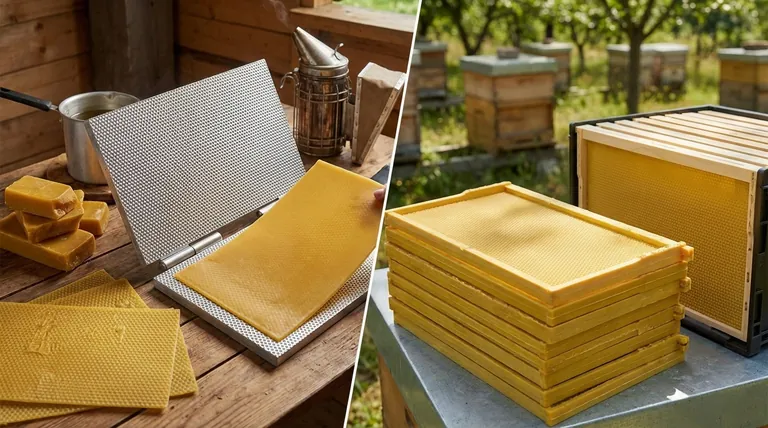The foundation of any beehive is the internal structure upon which bees build their entire colony. The two main types of beehive foundations used in modern beekeeping are beeswax foundation and plastic foundation. Both serve the same primary purpose: to give bees a guide for building straight, uniform honeycomb inside the hive's frames, which makes inspection and honey harvesting manageable for the beekeeper.
Your choice between beeswax and plastic foundation is one of the first and most fundamental decisions in beekeeping. It represents a direct trade-off between the natural acceptance and familiarity of wax versus the durability, reusability, and pest resistance of plastic.

Understanding Beeswax Foundation
Beeswax foundation is the traditional choice, consisting of a thin sheet of pure beeswax that has been embossed with the hexagonal pattern of honeycomb cells. It's designed to mimic the environment bees create for themselves in the wild.
The Most Natural Option
Because it is made from the same material bees produce naturally, a beeswax foundation feels familiar to them. This is its single greatest advantage.
Primary Advantage: Rapid Acceptance
Bees typically accept and begin drawing out comb on beeswax foundation very quickly. This can lead to faster colony buildup, especially for a new package of bees.
Key Disadvantage: Fragility
Beeswax foundation is delicate. It can easily be damaged during hive inspections and is prone to sagging or melting in very high temperatures. It is also highly susceptible to pests like wax moths.
Understanding Plastic Foundation
Plastic foundation is the modern, high-durability alternative. It is a rigid sheet of food-grade plastic molded with the hexagonal cell pattern.
The Modern, Durable Choice
The core benefit of plastic foundation is its strength and longevity. It is a robust tool designed for efficiency and long-term use.
Primary Advantage: Durability and Reusability
Plastic will not break during honey extraction in a high-speed centrifuge. It is highly resistant to pests and mold and can be scraped clean and reused for many years, making it a favorite for large-scale operations.
The Importance of a Wax Coating
Bees will not naturally build on bare plastic. For this reason, nearly all plastic foundations are sold with a thin coating of beeswax to encourage the colony to accept and use them.
Understanding the Trade-offs: A Direct Comparison
Choosing between these two options involves weighing their distinct characteristics against your beekeeping goals and management style.
Installation and Setup
Beeswax foundation often requires careful wiring into frames to provide support and prevent sagging. Plastic foundation, by contrast, typically snaps directly into specially designed frames with no extra work.
Honey Extraction
The strength of plastic is a clear winner during honey harvesting. It can withstand the force of a centrifugal extractor at high speeds, whereas new comb on a beeswax foundation can easily blow out and be destroyed.
Pest and Heat Resistance
Plastic foundation is virtually indestructible to wax moths, a common and destructive hive pest. It also remains rigid in high heat that would cause a beeswax foundation to warp or collapse.
Cost Over Time
While the initial purchase price can be comparable, the reusability and long lifespan of plastic foundation often make it a more cost-effective investment over the long term.
Making the Right Choice for Your Goal
Your beekeeping philosophy and operational needs should guide your decision.
- If your primary focus is a natural, traditional approach: Beeswax foundation is the clear choice, as it most closely mimics the bees' own building material.
- If your primary focus is efficiency, durability, and ease of management: Plastic foundation offers significant long-term advantages in strength, pest resistance, and reusability.
Ultimately, understanding these core differences empowers you to select the foundation that best aligns with your goals for your apiary.
Summary Table:
| Feature | Beeswax Foundation | Plastic Foundation |
|---|---|---|
| Material | Pure, embossed beeswax | Rigid, food-grade plastic with wax coating |
| Primary Advantage | Rapid bee acceptance & natural feel | Extreme durability & reusability |
| Key Disadvantage | Fragile; prone to sagging & pests | Requires wax coating for bee acceptance |
| Best For | Natural, traditional beekeeping | Efficient, large-scale, or pest-prone operations |
Equip Your Apiary with the Right Foundation from HONESTBEE
Choosing the correct foundation is critical for colony health and operational efficiency. Whether you prioritize the natural acceptance of beeswax or the unmatched durability of plastic for your commercial apiary or distribution business, HONESTBEE has you covered.
We supply high-quality, wholesale beekeeping supplies and equipment tailored for commercial beekeepers and distributors. Let us help you build a stronger, more productive operation.
Contact HONESTBEE today to discuss your foundation needs and wholesale pricing!
Visual Guide

Related Products
- Notebook Style Beeswax Foundation Mould Wax Foundation Mold
- Food Grade Plastic bee Foundation for Bee Frames
- Electric Beeswax Foundation Machine With Operating Tray and Wax Foundation Roller
- Electric Flatting and Embossing Machine with Tray for Beekeeping
- Electric Beeswax Flat Sheet Machine with Operating Tray for Wax Processing
People Also Ask
- How is beeswax foundation installed and what are its characteristics? Boost Hive Health Naturally
- What is beeswax foundation made of? A Guide to Stronger, More Efficient Hives
- What is required when using wax foundation in beekeeping frames? Essential Support for Strong Combs
- Can beeswax foundation be recycled or reused? A Guide to Sustainable Beekeeping
- How do bees build their honeycomb? A Marvel of Collective Engineering and Efficiency
















